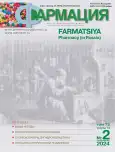Quantitative analysis of rutin in flavonoid-rich plant raw material by HPTLC
- 作者: Kobakhidze T.I.1, Agatonovic-Kustrin S.1,2, Gegechkori V.I.1, Chugaev D.V.1, Ramenskaya G.V.1
-
隶属关系:
- Sechenov Fist Moscow State Medical University (Sechenov University)
- La Trobe University
- 期: 卷 73, 编号 2 (2024)
- 页面: 13-17
- 栏目: Pharmaceutical chemistry and pharmacognosy
- URL: https://journals.eco-vector.com/0367-3014/article/view/629394
- DOI: https://doi.org/10.29296/25419218-2024-02-02
- ID: 629394
如何引用文章
详细
Introduction. Due to the increasing requirements for the quality of pharmaceutical products, the requirements for standardization of herbal medicines are also growing, which in turn necessitates the development of approaches to quality control of medicinal plant raw materials. The use of such an advanced method as high-performance thin-layer chromatography (HPTLC) will improve the quality of drug standardization, which is associated with the advantages of this method: minimized sample preparation, parallel determination of small volumes, elution time, high sensitivity, efficiency and speed.
Objective. Quantitative determination of rutin by high-performance thin-layer chromatography, as well as comparison of the results of quantitative determination of the amount of flavonoids in terms of rutin by the spectrophotometric method.
Material and methods. Medicinal plant raw materials – violet herb – were subjected to extraction using a developed method with 70 and 96% ethanol. Quantitative determination of rutin in extracts was carried out by HPTLC and spectrophotometry.
Results. The developed method for the quantitative determination of rutin was validated in terms of linearity, specificity and accuracy. The difference in the extractive ability of the solvents used was shown. The percentage of rutin determined using the HPTLC method in an ethanol (96%) extract (3 µl) is 3.0826%, in an ethanol (70%) extract (3 µl) – 1.5911%. The percentage of rutin determined using the HPTLC method in an ethanol (96%) extract (5 µl) is 3.0894%, in an ethanol (70%) extract (5 µl) – 1.6064%. The percentage of total flavonoids in terms of rutin determined using the spectrophotometric method in the ethanol (96%) extract is 3.4289%, in the ethanol (70%) extract – 2.4176%.
Conclusion. As a result of the study, a method for the quantitative determination of rutin was developed and validated, which can be used in the standardization of violet herb.
全文:
作者简介
Tamara Kobakhidze
Sechenov Fist Moscow State Medical University (Sechenov University)
编辑信件的主要联系方式.
Email: kobakhidze_t_i@staff.sechenov.ru
ORCID iD: 0000-0002-0026-4300
assistant at the Department of Pharmaceutical and Toxicological Chemistry named after. A.P. Arzamastsev Institute of Pharmacy named after. A.P. Nelyubin
俄罗斯联邦, Trubetskaya str., 8, bldg. 2, Moscow, 119991Snezana Agatonovic-Kustrin
Sechenov Fist Moscow State Medical University (Sechenov University); La Trobe University
Email: agatonovich-kushtrin_s@staff.sechenov.ru
ORCID iD: 0000-0002-7714-5510
Professor of the Department of Pharmaceutical and Toxicological Chemistry named after. A.P. Arzamastsev Institute of Pharmacy named after. A.P. Nelyubin; Department of Pharmacy and Biological Sciences
俄罗斯联邦, Trubetskaya str., 8, bldg. 2, Moscow, 119991; Edwards Road, Flora Hill, VIC 3550Vladimir Gegechkori
Sechenov Fist Moscow State Medical University (Sechenov University)
Email: gegechkori_v_i@staff.sechenov.ru
ORCID iD: 0000-0001-8437-1148
Ph.D. pharm. Sciences, Associate Professor of the Department of Pharmaceutical and Toxicological Chemistry named after. A.P. Arzamastsev Institute of Pharmacy named after. A.P. Nelyubin
俄罗斯联邦, Trubetskaya str., 8, bldg. 2, Moscow, 119991Dmitry Chugaev
Sechenov Fist Moscow State Medical University (Sechenov University)
Email: chugaev_d_v@staff.sechenov.ru
ORCID iD: 0000-0001-5127-5088
Ph.D. pharm. Sciences, Associate Professor of the Department of Pharmaceutical and Toxicological Chemistry named after. A.P. Arzamastsev Institute of Pharmacy named after. A.P. Nelyubin
俄罗斯联邦, Trubetskaya str., 8, bldg. 2, Moscow, 119991Galina Ramenskaya
Sechenov Fist Moscow State Medical University (Sechenov University)
Email: ramenskaya_g_v@staff.sechenov.ru
ORCID iD: 0000-0001-8779-3573
Dr. pharm. Sciences, Professor, Director of the Institute of Pharmacy named after. A.P. Nelyubin
俄罗斯联邦, Trubetskaya str., 8, bldg. 2, Moscow, 119991参考
- Государственная фармакопея, Издание XIV, Том I, ОФС.1.2.1.2.0003.15 «Тонкослойная хроматография». [Электронный ресурс]. Режим доступа: https://femb.ru/record/pharmacopea14. [State Pharmacopoeia, Edition XIV, Volume I, OFS.1.2.1.2.0003.15 “Thin-layer chromatography”. [Electronic resource]. Access mode: https://femb.ru/record/pharmacopea14 (in Russian)]
- Государственная фармакопея, Издание XIV, Том IV, ФС.2.5.0044.15 «Фиалки трава». [Электронный ресурс]. Режим доступа: https://femb.ru/record/pharmacopea14. [State Pharmacopoeia, Edition XIV, Volume IV, FS.2.5.0044.15 “Violet grass.” [Electronic resource]. Access mode: https://femb.ru/record/pharmacopea14 (in Russian)]
- Государственная Фармакопея, Издание XIV, Том I, ОФС.1.1.0012.15 «Валидация аналитических методик». [Электронный ресурс]. Режим доступа: https://femb.ru/record/pharmacopea14. [State Pharmacopoeia, Edition XIV, Volume I, OFS.1.1.0012.15 “Validation of analytical methods.” [Electronic resource]. Access mode: https://femb.ru/record/pharmacopea14 (in Russian)]
- Коренская И.М., Ивановская Н.П., Измалкова И.Е. Лекарственные растения и лекарственное растительное сырье, содержащее флавоноиды, кумарины и хромоны: учебн. Пособие. Воронеж: Изд-во ВГУ, 2007; 78. [Korenskaya I.M., Ivanovskaya N.P., Izmalkova I.E. Medicinal plants and medicinal plant materials containing flavonoids, coumarins and chromones: textbook. Allowance. Voronezh: VSU Publishing House, 2007; 78 (in Russian)]
- Корулькин Д.Ю., Абилов Ж.А., Музычкина Р.А., Толстиков Г.А. Природные флавоноиды. Новосибирск: Академическое изд-во «Тео», 2007; 232. [Korulkin D.Yu., Abilov Zh.A., Muzychkina R.A., Tolstikov G.A. Natural flavonoids. Novosibirsk: Academic Publishing House "Teo", 2007; 232 (in Russian)]
- Беккер Ю. Хроматография. Инструментальная аналитика: методы хроматографии и капиллярного электрофореза. Перевод с немецкого В.С. Куровой под редакцией А.А. Курганова. ТЕХНОСФЕРА. Москва, 2009; 472. [Becker Y. Chromatography. Instrumental analytics: methods of chromatography and capillary electrophoresis. Translation from German by V.S. Kurova, edited by A.A. Kurganova. TECHNOSPHERE. Moscow, 2009; 472 (in Russian)]
- Phyto-Analytical Evaluation Of Rutin In Viola odorata L., (Banafshan) – An Expectorant. Zeeshan Ahmed Sheikh, Aqib Zahoor, Hina Hussain. J. of Pharmacy and Pharmaceutical Sciences. 2014; 2 (1).
补充文件






